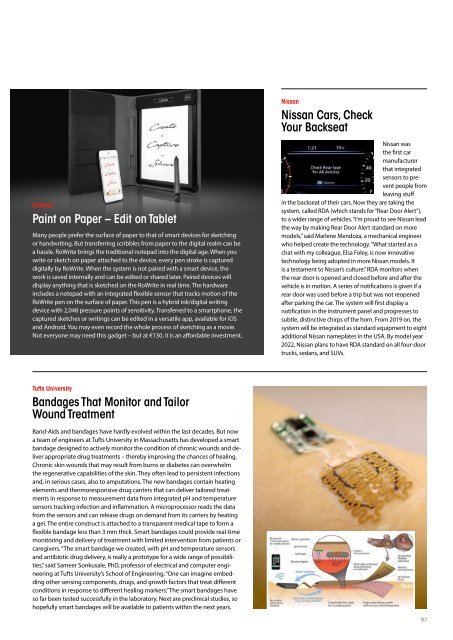Smart Industry 2/2018
Smart Industry 2/2018 - The IoT Business Magazine - powered by Avnet Silica
Smart Industry 2/2018 - The IoT Business Magazine - powered by Avnet Silica
You also want an ePaper? Increase the reach of your titles
YUMPU automatically turns print PDFs into web optimized ePapers that Google loves.
Nissan<br />
Nissan Cars, Check<br />
Your Backseat<br />
RoWrite<br />
Paint on Paper – Edit on Tablet<br />
Many people prefer the surface of paper to that of smart devices for sketching<br />
or handwriting. But transferring scribbles from paper to the digital realm can be<br />
a hassle. RoWrite brings the traditional notepad into the digital age. When you<br />
write or sketch on paper attached to the device, every pen stroke is captured<br />
digitally by RoWrite. When the system is not paired with a smart device, the<br />
work is saved internally and can be edited or shared later. Paired devices will<br />
display anything that is sketched on the RoWrite in real time. The hardware<br />
includes a notepad with an integrated flexible sensor that tracks motion of the<br />
RoWrite pen on the surface of paper. This pen is a hybrid ink/digital writing<br />
device with 2,048 pressure points of sensitivity. Transferred to a smartphone, the<br />
captured sketches or writings can be edited in a versatile app, available for iOS<br />
and Android. You may even record the whole process of sketching as a movie.<br />
Not everyone may need this gadget – but at €130, it is an affordable investment.<br />
Nissan was<br />
the first car<br />
manufacturer<br />
that integrated<br />
sensors to prevent<br />
people from<br />
leaving stuff<br />
in the backseat of their cars. Now they are taking the<br />
system, called RDA (which stands for “Rear Door Alert”),<br />
to a wider range of vehicles. “I’m proud to see Nissan lead<br />
the way by making Rear Door Alert standard on more<br />
models,” said Marlene Mendoza, a mechanical engineer<br />
who helped create the technology. “What started as a<br />
chat with my colleague, Elsa Foley, is now innovative<br />
technology being adopted in more Nissan models. It<br />
is a testament to Nissan’s culture.” RDA monitors when<br />
the rear door is opened and closed before and after the<br />
vehicle is in motion. A series of notifications is given if a<br />
rear door was used before a trip but was not reopened<br />
after parking the car. The system will first display a<br />
notification in the instrument panel and progresses to<br />
subtle, distinctive chirps of the horn. From 2019 on, the<br />
system will be integrated as standard equipment to eight<br />
additional Nissan nameplates in the USA. By model year<br />
2022, Nissan plans to have RDA standard on all four-door<br />
trucks, sedans, and SUVs.<br />
Tufts University<br />
Bandages That Monitor and Tailor<br />
Wound Treatment<br />
Band-Aids and bandages have hardly evolved within the last decades. But now<br />
a team of engineers at Tufts University in Massachusetts has developed a smart<br />
bandage designed to actively monitor the condition of chronic wounds and deliver<br />
appropriate drug treatments – thereby improving the chances of healing.<br />
Chronic skin wounds that may result from burns or diabetes can overwhelm<br />
the regenerative capabilities of the skin. They often lead to persistent infections<br />
and, in serious cases, also to amputations. The new bandages contain heating<br />
elements and thermoresponsive drug carriers that can deliver tailored treatments<br />
in response to measurement data from integrated pH and temperature<br />
sensors tracking infection and inflammation. A microprocessor reads the data<br />
from the sensors and can release drugs on demand from its carriers by heating<br />
a gel. The entire construct is attached to a transparent medical tape to form a<br />
flexible bandage less than 3 mm thick. <strong>Smart</strong> bandages could provide real-time<br />
monitoring and delivery of treatment with limited intervention from patients or<br />
caregivers. “The smart bandage we created, with pH and temperature sensors<br />
and antibiotic drug delivery, is really a prototype for a wide range of possibilities,”<br />
said Sameer Sonkusale, PhD, professor of electrical and computer engineering<br />
at Tufts University’s School of Engineering. “One can imagine embedding<br />
other sensing components, drugs, and growth factors that treat different<br />
conditions in response to different healing markers.” The smart bandages have<br />
so far been tested successfully in the laboratory. Next are preclinical studies, so<br />
hopefully smart bandages will be available to patients within the next years.<br />
97
















